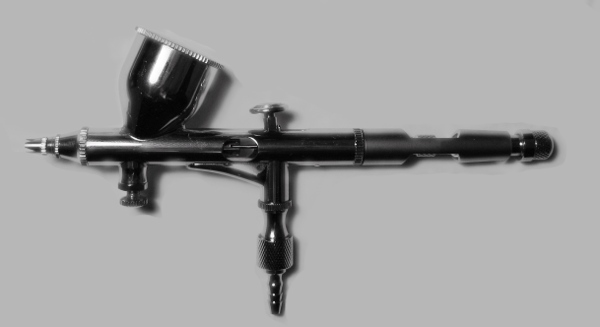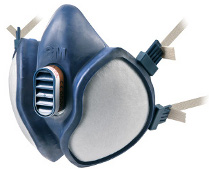Review BD-180 Airbrush

I picked up modelling again after 20 years or so, and started with just painting models with brushes. Final results were a bit disappoint by loosing detail by too thick paint. Therefore decided to buy a cheap airbrush and compressor, and see where this would lead to. I ended up with buying a (Fengda) Fenghua Bida Machinery Manufacture Co., Ltd. brush and compressor. Here's my experience so far - after I would say occasional use.
Airbrush Review
I bought the airbrush for about 30 Euro's. It has a 0.2mm nozzle according to the SPECLFLCATIONS on the leaflet, but is advertised as a 0.25mm nozzle. It is a Chinese copy of Iwata's Custom Micro CM-C Plus.
On the positive side
-
Cheap, good for novices who don't want to spend a fortune on equipment. Great way to learn how to use an airbrush. Most importantly, this means learn how to take care of it by adapting to a cleaning regime which does not block the airbrush with dried paint (see below).
On the negative side
-
The needle cap is too narrow. It interferes the paint spray a bit, which accumulates paint on the inside of the needle cap until being blown away as bigger droplets ruining your paint-job. I sanded off part of it, but in the end started to use the airbrush without the needle cap (although this has the risk of damaging the needle).
-
The needle chucking guide has about 1mm play. When the needle retracts, this causes the needle to not only move backwards, but als a little downwards. This in turn causes the needle to be excentric in the nozzle when it progressively is pulled backwards. I did not notice this in an uneven spray pattern of the airbrush though, but things like this are typical for its quality.
-
The previously described issue causes a bigger, noticeable problem with the handle (the back part of the airbrush with the cut-out). You're likely to touch the needle when you're spraying paint, causing much more paint to flow than intended. So pay attention to turn the handle in such a way that the cut-out is not positioned sideways (so basically not how it is shown in the picture).
-
Broken nozzle threat and leaking air-valve. The air-valve was leaking air, always flowing a bit of air through the airbrush. Secondly, the threat broke off from the nozzle inside the bore of the airbrush while unscrewing the nozzle the 10th time or so. I returned my airbrush and got a new one which did not have a leaking air-valve. I guess I had a bad model first time
-
The needle sometimes tends to stick in it's retracted position, which also causes paint droplets. It might be just my airbrush, but could well be manufacturing quality. I found out the spring tensioning cap (for the spring which presses the needle back into the nozzle), can be turned such a way that the needle jams inside the housing.
Wish-list for my next airbrush (if this one finally breaks down):
-
Better quality
-
Wider needle cap
-
Don't need a Micro Air Control Valve (that's the valve below the cup)
-
Wider (>0.3mm), threat-less nozzle
-
Teflon seals?
So an option I'm considering is Iwata's Revolution (HP-CR), which is entry level (around 90 Euro's), but uses a nozzle with threat, which is a weak point from my experience. Iwata's Eclipse (HP-CS, around 110 Euro's) is next step up, and seems to fit the bill.
Using the airbrush
-
Safety first: use a respirator suited for spray painting. Airbrushes produce a very fine mist of foreign particles that do not belong in you lungs. I use a 3M 4251 respirator.
-
Clean, clean,clean! Extra handicap is that I use acrylic paints which dry fast, so also in my airbrush. At first I used to spray all paint I did not need anymore through the airbrush in a bottle, but this still produced a lot of paint cloud outside the bottle, and clogged my airbrush too soon. Nowadays I poor all the paint I don't need anymore away in another cup, and spray airbrush cleaner (I use Createx) through the airbrush on/into tissue paper until I see no paint anymore on the tissue paper and at the bottom of the paint cup where you can see the needle. Also, spraying longer than say 5 minutes or so lets the paint dry in the airbrush already, so I'm now used to empty and clean the airbrush after about 5 minutes. When putting the airbrush away for a moment to mix paint, I leave a bit of cleaner inside the brush. Occasionally in between spray jobs I retract the needle, and use a q-tip drenched in alcohol and touch the tip of the nozzle, which seems to suck in a bit of alcohol by capillary action. The q-tip sometimes shows some paint left at the end of the nozzle, so it seems to help the nozzle stay clean. At the end of the spray sessions (and sometimes in between), I remove the needle, clean it with airbrush cleaner or alcohol. I remove the nozzle, use a small brush with cleaner or alcohol and clean it.
-
When all is well, you can really notice you run out of paint by a distinct different sound from your airbrush. I sometimes suspect dust coming from tissue paper which clogs up the airbrush, and this can take several tries of cleaning until suddenly it starts spraying well again. I'm still looking for a cheap lint-free cloth option though.
-
Paint dilution. I use Vallejo Air paint, and found a lot of differences in paint thickness between bottles, but almost always I need to thin the paint for more than 50%, sometimes up to 100%. For thinning, I use about 50% distilled water, and 50% Vallejo's thinner. Strangely enough, it looks to me Vallejo's thinner itself is already too thick to be used in an airbrush. Recommendable is Geoff Illsley's / Compendium Series DVD about painting figures. This clearly explains how to mix paint correctly, and taking care of the airbrush.
-
Pressure. About 1.5 bar. This seems to affect if the paint reaches the surface wet or dry, but also how much I dilute the paint.
-
Last but not least, airbrush shops sell speedshapes (they look like computer mice outer shells, but a bit bigger), which are excellent to practice airbrushing and weathering painting skills.
I think that's about it. Enjoy.
